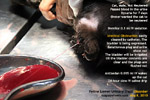|
Toa Payoh
Vets Clinical Research
Making veterinary surgery alive
to a veterinary student studying in Australia
using real case studies and pictures |
The Young Cat Passes Blood In The Urine - Is it urine
spraying?
Dr Sing Kong Yuen, BVMS (Glasgow), MRCVS
Date:
08 August, 2010 |
 toapayohvets.com toapayohvets.com
Be Kind To Pets
Veterinary Education
Project 2010-0129 |
"My cat passes blood in the urine
today," the woman in her 40s
brought in a 1.5-year-old male cat
for neutering. "Can you neuter him
today?"
"If your cat is passing blood in
the urine, he should be treated
for this serious problem first. He
is not healthy and may die if he
is neutered" I said as the cat was
presenting the symptom of
haematuria (blood in the urine).
HISTORY & GENERAL EXAMINATION
I palpated the bladder. It was
half the size of the tennis ball.
His penile tip was red due to
licking. He was still active,
eating and drinking.
I asked: "Did your cat have
difficulty in peeing or peeing in
small amounts in the litter box?"
The woman said: "For the past
week, he pees anywhere in the
apartment." This cat was avoiding
the litter box as he associated
his pain in peeing to the litter
box. The owner thought he had
started urine-spraying and wanted
me to neuter him immediately.
There were two other cats in the
apartment and he could be marking
his territory as an intact male.
Stress in living with other cats
is said to be a cause of
haematuria. So the owner wanted
him neutered to prevent urine
spraying but she did not say so.
"Do you feed dry food to your
cat?" I asked.
"Yes, all my 3 cats eat dry food."
TREATMENT
The cat was still active and
eating. He had no fever. His
bladder was swollen on palpation.
He was less than two years old but
he could still be suffering from
FLUTD (feline lower urinary tract
disorder). Dysuria (difficulty in
urination) and haematuria (blood
in the urine) were the symptoms.
This cat has a case of FLUTD.
CAUSE
More than 60% of the FLUTD have
unknown causes and are said to be
idiopathic. 20% of the cases are
attributed to bladder stones.
Bladder and kidney tumours and
abnormalities of the urinary tract
are unlikely in this young cat.
Bacterial infection of the bladder
or kidney is possible. Stress is
said to be a factor in FLUTD and
this male cat was stressed in that
2 other cats in the apartment
occupied part of his turf.
TREATMENT
1. Drugs
I injected an antibiotic, an
anti-spasmodic and steroidal
anti-inflammatory SC and waited
for one hour. The cat did not pee
but the bladder had swollen much
bigger. In some cases, these drugs
worked when the cat went home and
no further procedures are done.
But this cat has passed blood in
the urine and was in a more
serious condition of FLUTD. He
might die from kidney failure if
the urinary obstruction was not
cleared today.
2. Relieve urinary tract
obstruction.
I passed a catheter into the cat.
It was difficult to be passed into
the bladder at some point but
after entering the bladder, fresh
red blood shot out strongly like a
firing gun. I directed the urine
stream to the kidney dish and to a
collection bottle.
 Around
200 ml of red blood was expressed
and syringed out and a sample was
taken for urinalysis. Pinkish
gelatinous tissues also flowed
out. The catheter was stitched to
the prepuce at two places opposite
each other (catheter has holes,
see picture). Around
200 ml of red blood was expressed
and syringed out and a sample was
taken for urinalysis. Pinkish
gelatinous tissues also flowed
out. The catheter was stitched to
the prepuce at two places opposite
each other (catheter has holes,
see picture).
3. The cat was given domitor 0.1
ml IV sedation. The catheter
emptied his bladder of urine. You
will note that cat urinary
catheters have a very small hole
at its tip. This would be OK for
normal urine. But the cat with
FLUTD had gelatinous mucosal plugs
inside the bladder.
TIP: I took out the
catheter and cut a bigger hole at
its tip so that the mucous plug
from the bladder mucosa can get in
and be flushed out with the normal
saline. I used a 20-ml syringe to
pass normal saline into the
bladder to irrigate the mucosa of
the bladder. I could see pinkish
plugs being passed out as I took
out the syringe. After another 100
ml of normal saline, the bladder
passed out clear saline.
An e-collar was given. The cat was
given a
slow IV saline drip for the
next 24 hours.
4. FURTHER TREATMENT
Another two irrigations of the
bladder the next day. The cat was
warded for two days.
5. TESTS
5.1 BLOOD TEST for white cell
count (infection)
5.2 URINE TEST for crystals
(struvite or calcium oxalate),
protein (kidney disorder) and
bacteria (infections).
5.3 DIPSTICK TEST showed a high
urinary pH and lots of blood.
X-rays or ultrasound (bladder
stones) and IVP (Intravenous
Pyelogram) tests are not done at
this stage to save on costs. If
FLUTD recurs, these tests may be
done.
CONCLUSION
The cat is being warded and
observed. No dry cat food. Canned
food, prescription canned food or
home-cooked food is recommended.
Prescription canned food for cats
with struvite or calcium oxalate
crystals (pending lab results)
would be recommended. Repeated
bladder irrigations to clear the
gelatinous plugs from the bladder
for the next 2 days and no dry cat
food are a key to success in the
management of this case. Owners
who would not give the vet the
opportunity to do it by taking the
cat home on the same day may find
recurrence of FLUTD.
TIP: A follow-up urinary pH
test every month is advised but
few cat and dog owners of cats or
dogs with urinary tract disorders
or stones will do it. If the urine
is highly alkaline, acidify
the urine for 1-2 months and give
anti-struvite or anti-oxalate
canned cat food. Give home-cooked
food as an alternative with plenty
of water for drinking. No dry
food to be fed.
Different cats are treated
differently as not all cases have
blood in the urine. It is best to
consult your vet rather than do
self-treatment in FLUTD.
|
|
|
 BE
KIND TO OLDER DOGS & CATS ---
GET TUMOURS REMOVED EARLY ---
WHEN THEY ARE SMALLER. More case studies, goto:
Cats or
Dogs BE
KIND TO OLDER DOGS & CATS ---
GET TUMOURS REMOVED EARLY ---
WHEN THEY ARE SMALLER. More case studies, goto:
Cats or
Dogs |
|
|
To make
an appointment: e-mail
judy@toapayohvets.com
tel: +65 9668-6469, 6254-3326 |
 toapayohvets.com toapayohvets.com
Be Kind To Pets
Veterinary Education
Project 2010-0129 |
|
|
 Toa
Payoh Vets Toa
Payoh Vets
Clinical Research
|
|
|
Copyright ©
Asiahomes Internet
All rights reserved. Revised: August 08, 2010
Toa Payoh Vets
|
|
 TOA
PAYOH VETS
TOA
PAYOH VETS TOA
PAYOH VETS
TOA
PAYOH VETS